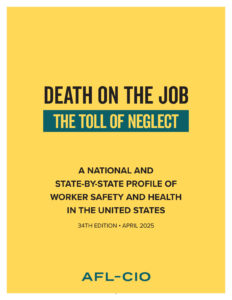 The AFL-CIO’s 34th annual ‘Death on the Job’ report provides a state-by-state analysis of threats to worker health and safety and policy recommendations for how the government can better protect workers
The AFL-CIO’s 34th annual ‘Death on the Job’ report provides a state-by-state analysis of threats to worker health and safety and policy recommendations for how the government can better protect workers
WASHINGTON, D.C.—Workers are dying and being injured on the job, and the Trump administration and DOGE are putting them at greater risk by enacting policies that will create deplorable working conditions, according to a new report released today by the AFL-CIO.
Ahead of Workers Memorial Day, the AFL-CIO released its 34th annual “Death on the Job: The Toll of Neglect” report, a comprehensive analysis of the state of workers’ health and safety at the national and state levels. Findings include:
- Inadequate workplace safety laws and policies resulted in the deaths of 5,283 workers on the job in 2023, the latest year of data available, and an estimated 135,304 workers from occupational diseases.
- Black and Latino workers are still disproportionately dying on the job, both at rates higher than the national job fatality rate.
- The report shows 659 Black worker deaths, the second-highest number in more than two decades.
- The report also shows 1,250 Latino worker deaths, making Latino workers the group at the greatest risk of dying on the job among all demographics.
The national job fatality rate was slightly lower in 2023 than in 2022, thanks to strong, pro-worker policies. But the Trump administration’s substantial cuts to—and in some cases, effective elimination of—federal agencies that protect the health and safety of 161 million American workers will likely increase mortality. These cuts include gutting the National Institute for Occupational Safety and Health (NIOSH), the agency that delivers critical health and safety expertise for both workers and employers; eliminating 11 offices of the Occupational Safety and Health Administration (OSHA) in states with the highest workplace fatality rates; eliminating 34 offices of the Mine Safety and Health Administration (MSHA), which protects coal miners from hazards like black lung disease, in 19 states, while simultaneously pausing a new silica rule that would prevent coal miners from acquiring silicosis; and allowing Elon Musk, whose companies are being investigated for dozens of workplace safety and health violations, to pursue access to sensitive OSHA data through his inquisition into the Department of Labor.
“Every worker has the fundamental right to come home safe at the end of their workday. But for too many workers, that basic right is under attack,” said Liz Shuler, president of the AFL-CIO. “Workers fought and died for generations for the health and safety laws and protections we have today, and this year’s report shows we need to do even more. The Trump administration and DOGE are gutting the federal agencies that hold bosses accountable for endangering workers, firing the federal workers who monitor and research health hazards, indicating that they will repeal crucial worker safety regulations, and giving billionaires like Elon Musk the power to access and even manipulate OSHA whistleblower records. We can’t bring back the thousands of workers lost each year, but we can fight to prevent more devastation to working families across this country and demand that the Trump administration reverse course.”
“This year’s ‘Death on the Job’ report once again shows that, as in every crisis, the crisis of worker mortality is hitting Black and Latino workers the hardest,” said Fred Redmond, secretary-treasurer of the AFL-CIO. “It is unacceptable that employers are continuing to fail all workers, and especially Black and Latino workers, by not providing them the safety measures and resources they need to stay safe on the job. Enough is enough. The AFL-CIO is fighting the scourge of workplace mortality, and we will not rest until the number of workers who die on the job is zero.”
The 2025 “Death on the Job” report comes just before Workers Memorial Day, the annual commemoration of workers who have died on the job and our fight to prevent these tragedies. The AFL-CIO, its state and local labor federations, and affiliated unions are raising awareness of the Trump administration’s threats to worker health and safety with events across the country this week and next, including a hearing about cuts to worker health and safety programs that took place on Monday, April 21. At the hearings, federal workers, union leaders and community members shared their stories about the impacts of the Trump administration’s actions.
Read the full report here.







